|

Contents
|
 |
Pierre
Plantard Profile
from
PrioryOfSion Website
-
Name:
Pierre Athanase Marie Plantard
-
Date of Birth:
18 March 1920 (Paris)
-
Parents:
Pierre Plantard (a butler) and Amélie Marie Raulo (occasionally
worked as a cook for wealthy families).
-
Education:
Left school in 1937 failing to achieve above average education.
-
Addresses between 1937-1943:
22 Place Malesherbes (Paris 17); 10 Rue Lebouteux (Paris 17).
-
First Job:
Sexton for the Church of Saint-Louis d'Antin, Paris.
Interests between 1937-1943
Actively Anti-semitic and Anti-masonic in the guise of creating two
phantom associations: Renovation Nationale Française and Alpha
Galates; admirer of Field Marshal Pétain to whom he wrote a letter
on 16 December 1940 warning of a Jewish Masonic conspiracy –
resulting in various investigations being carried out on him by both
the French and German authorities – culminating in his being
sentenced to Fresnes prison for four months for setting-up the Alpha
Galates without being granted permission to do so by the
authorities.
Edited a journal called Vaincre under the alias of
"Pierre de France" between 1942-1943, which included articles
allegedly written by various people – Le Comte Moncharville, Robert
Amadou, Dr Camille Savoire, etc – when in fact Pierre Plantard
solely wrote these. Quoting from a Report done by the French
Authorities dated 9 May 1941 and held at the Bureau of Associations
in the Paris Prefecture of Police:
"Plantard, who boasts of having
links with numerous politicians, seems to be one of those dotty,
pretentious young men who run more or less fictitious groups in an
effort to look important and who are taking advantage of the present
trend towards taking a greater interest in young people in order to
attract the Government's attention" (File Ga P7).
Interests 1956
Having moved from Paris to the town of Annemasse in the southern
Haute Savoie region of France – Plantard formed, with André Bonhomme
– a small association called the Prieuré de Sion on 7 May 1956 (its
Registration Papers existing at the Sub-Prefecture of Saint
Julien-en-Genevois, and it was named after a small hill outside
Annemasse named Mont Sion) – devoted to the Defence and Liberty of
Low-Cost Housing and acting as a support group for the opposition
candidate at the local Council elections – the Prieuré de Sion
actively criticised and attacked the Annemasse property developers
in its journal, Circuit; its headquarters were based at Plantard’s
home in the street of Sous-Cassan.
A Report dated 4 May 1954 on
Pierre Plantard reveals that he had moved to Annemasse by 1951 and
was "married and had a daughter aged about three". The Prieuré de
Sion terminated sometime after October 1956, following Plantard’s
conviction for ‘détournement de mineurs’ (reportedly serving a 12
month prison sentence between 1956-1957).
Interests 1958-1960
The Fifth French Republic was formed in 1958 with General de Gaulle
being its President – Plantard formed a "Committee of Public Safety"
during this time which was reported about in three articles dated 6
June, 8-9 July and 29 July in the Le Monde Newspaper.
Plantard
followed this by editing a second series of the journal Circuit,
subtitled The Cultural Periodical of the French Forces’ Federation –
it could be described as a reborn Vichyite journal containing
articles of a metaphysical nature resembling those that were written
by right-wing esoterics during the late 1800s. Plantard advertised
his psychic abilities in Circuit Number 9 (1960).
Interests: 1960-1985
Revived the Prieuré de Sion and gave it a fictitious pedigree
(created by Godfrey de Bouillon during the Crusades); Plantard first
developed an interest in the story of Gisors as given by Roger
Lhomoy, before progressing into the story of Rennes-le-Château as
initially given by Noel Corbu, with whom he met and was greatly
impressed by. By 1964 Plantard created the novel claim about himself
that he was directly descended from the Merovingian king Dagobert II
– and the central purpose of being of this version of the Prieuré de
Sion was this very claim (Plantard was really descended from a 16th
century peasant who picked walnuts).
Plantard also became acquainted
with Philippe de Chérisey and Gérard de Sède during this period of
time – the latter being an author who successfully managed to
transform Plantard’s creations/allegations into published books –
Plantard had previously failed to get any of his own manuscripts
published, which included one on Rennes-le-Château – this latter
manuscript became the book L’Or de Rennes that was re-written by
Gérard de Sède and published in 1967.
With the help of Philippe de Chérisey, Plantard began creating false stories about the priest
Bérenger Saunière at Rennes-le-Château and in particular creating
false pieces of evidence like "parchments", "gravestones", and
"genealogies" (click below image) – the "parchments" in
particular were created by Philippe de Chérisey and the book
contract to L’Or de Rennes reveals he was entitled to a share of the
book’s profits for producing the "parchments".
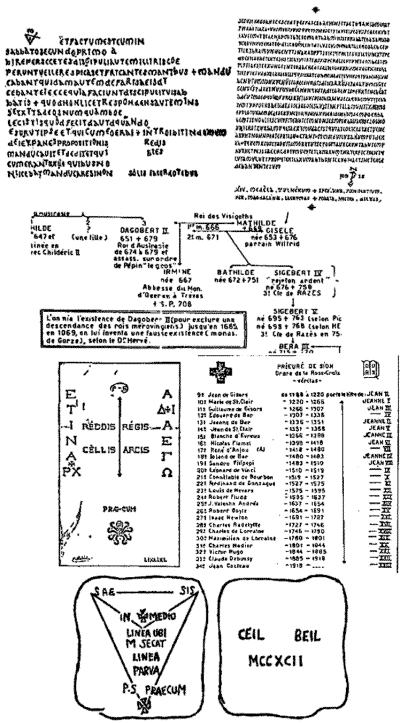
A split between the
three occurred in 1967 when Gérard de Sède refused to split the book
royalties and Plantard and de Chérisey declared the "parchments" to
be forgeries (the book’s main attraction and major selling point).
The period between 1967-1985 represented one of producing more and
more false allegations and more and more forgeries – including a
List of Grand Masters that was plainly inspired by the AMORC list of
famous people that included the names of Leonardo da Vinci, Robert
Fludd, Botticelli, Valentin Andreae, etc.
Plantard’s activities from
this point on were plainly laughable but he managed to get away with
it simply because people chose to believe his stories – until a
conflict with the author and researcher Jean-Luc Chaumeil (who
discovered details about Plantard’s past and began publishing them)
– forced Plantard into quitting by "resigning" from the Prieuré de
Sion on 10 July 1984 – although the last Priory Document
representing this version of the Prieuré de Sion was deposited in
the Bibliothèque Nationale on 1 October 1985.
A split also developed
between Pierre Plantard and Philippe de Chérisey when the latter
started collaborating with Paul Rouelle (involving a character named
the Marquis de B. who actually never existed).
Interests 1989-1993
The ‘Saunière Museum’ was opened in Rennes-le-Château in 1989 and
this, it seems, inspired Plantard into making an unsuccessful
comeback (the French did not take any notice of this) – a third
version of the Prieuré de Sion was launched with a revived series of
the journal Vaincre – giving a different false pedigree and
different Grand Masters List and alleging that the previous version
was all a fake produced by Philippe Toscan du Plantier under the
influence of LSD – there was no connection with the Templars or with
Godfrey de Bouillon – the Prieuré de Sion was founded in 1681 at
Rennes-le-Château by the Grandfather of Marie de Negri d’Ables – and
there were secret archives discovered in Barcelona in Spain as well.
Plantard was still descended from Dagobert II, but indirectly: the
‘real’ direct descendant was Otto Von Habsburg! The revised list of
Grand Masters contained the name of Roger Patrice Pelat whose name
was linked to a financial scandal that was being investigated by
Judge Thierry Jean-Pierre – the Judge interrogated Plantard who
under Oath admitted that everything was made-up. Plantard was
let-off with a severe warning and never again revived his Prieuré de
Sion activities, living out the rest of his life in seclusion in
various addresses at Perpignan, Paris and Barcelona. He died on 3
February 2000 in Paris and his remains were cremated.
Criminal Convictions
-
Four months in Fresnes Prison during the 1940s.
-
Six months between 1953-1954 for abuse of trust in relation to
offences against property.
-
12 months between 1956-1957 for ‘détournement de mineurs’.
Back to Contents
Pierre Plantard’s Criminal Convictions
from
PrioryOfSion Website
A Chronology
It is well known that Pierre Plantard spent time in prison during
the 1940s and the 1950s – the evidence for this can be found in the
Prefectures of Police at Paris and Saint Julien-en-Genevois (where
the Priory of Sion was originally formed in 1956).
Recent written
enquiries to both of the Prefectures of Police have confirmed that Plantard spent time in prison during the 1940s and the 1950s – but
the nature of the French Privacy Law prohibits the precise details
of his convictions from becoming officially public – similar
prohibitive legal restrictions exist in other countries like
Switzerland and Germany.
In France, criminal convictions become
amnestied and so therefore any publicity of any person’s past crimes
automatically constitutes defamation there – which is why French
authors cannot refer to Plantard’s criminal convictions either in
their respective publications or on filmed television interviews.
In countries like England the matter is straightforward – references
to anyone’s criminal convictions can be made public (either in
publications or on filmed television documentaries) without any
legal restrictions and the information is readily accessible at the
National Archives in Kew, Surrey.
Pierre Plantard’s Judicial Records are kept at the Tribunal de
Grand
Instance de Thonon-les-Bains but cannot be opened without breaking
the French Privacy Law.
Here is a Chronology, with references, of Pierre Plantard’s criminal
convictions:
1940s
Police Report dated 13 February 1945 in the Paris Prefecture of
Police (part of File Ga P7) states that Pierre Plantard served 4
months in Fresnes prison for setting-up an association (the Alpha Galates) without being given permission to do so by the German
authorities. Pro-French Nationalistic organizations such as the
Alpha Galates (albeit only phantom in existence) were deemed to be
highly unpopular by the German occupiers of France, who deemed their
pedigree to be Aryan in nature and virulently opposed to the Gallic
French Tradition, which Plantard promoted during the Occupation.
December 1953 – May 1954
Pierre Plantard in prison (see entry for 1956).
1954
Police Report in the Paris Prefecture of Police dated 4 May 1954
(part of File Ga P7) states that Pierre Plantard had "requested the
issue of a 'certificate of confinement'" – Plantard had been
sentenced in December 1953 to six months’ imprisonment and following
his release appears hoping to use evidence of his imprisonment by
the Germans as part of a character reference. The Police Report
dated 4 May 1954 contains testimony from Plantard’s mother relating
to Plantard’s imprisonment in Fresnes prison by the Germans.
June 1956
Letter dated 8 June 1956 by the Mayor of Annemasse to the Sub
Prefect of St Julien-en-Genevois disclosed information that Pierre
Plantard had broken sections of the French Penal Code relating to
crimes and offences against property and was sentenced to six months
imprisonment by the Tribunal of St Julien-en-Genevois in December
1953.
The Priory of Sion had been formed in May 1956 and was
originally dedicated to the defence of Low-Cost Housing, also
backing the opposition Candidate at the local Annemasse Council
elections – the Priory of Sion also attacked the Annemasse property
developers in the pages of its journal, Circuit. The letter dated 8
June 1956 by the Mayor of Annemasse was part of an investigation
into the Priory of Sion headed by the local Annemasse Council and
the Sub Prefecture of St Julien-en-Genevois into Pierre Plantard and
the first three issues of Circuit following the formation of the
Priory of Sion in May 1956.
Three recent letters dated 22 March 2004, 20 April 2004 and 10 May
2004 from Monsieur Serge Champanhet, the Secretary General of the
Sub-Prefecture of St Julien-en-Genevois (4 Avenue de Geneve, 74164
Saint Julien-en-Genevois, Haute-Savoie), have both confirmed the
existence of the 1956 letter and Plantard’s conviction.
October 1956
The last issue of Circuit is dated October 1956 and nothing more of
the Priory of Sion in its manifestation of defending Low-Cost
Housing is heard of again after that date. The October 1956 edition
of Circuit was a "special edition" giving the details of the Priory
of Sion becoming involved with the local Church in transporting
local children by bus to nurseries and primary schools – details of
the local children’s addresses were to be deposited at Pierre
Plantard’s address in Annemasse.
Unofficial sources testify that Pierre Plantard was sentenced to 12
months imprisonment between December 1956 and December 1957 for
breaking the French détournement de mineurs law (abuse of a minor).
1972
Two French investigators into Pierre Plantard – Jean-Luc Chaumeil
and "Pierre Jarnac" (Michel Vallet) – consult File KM 94550 at the
Sub Prefecture of St Julien-en-Genevois containing the 1956 Priory
of Sion Statutes and Registration Documents – and also see the
letter dated 8 June 1956 by the Mayor of Annemasse to the Sub
Prefect disclosing Plantard’s 1953 criminal conviction. Other French
researchers included Franck Marie and Gérard de Sède.
mid-1970s
BBC make three documentaries about Rennes-le-Château, with Roy
Davies, the Producer, asking to see a copy of the File relating to
Plantard’s criminal convictions (his request is contained in a
dossier of correspondence at the Sub Prefecture of St
Julien-en-Genevois).
6 December 1983
Pierre Plantard letter dated 6 December 1983 to Jean-Luc Chaumeil
alleged,
"I have never been convicted either of fraud or of bouncing cheques or of corruption of a minor... I have no criminal record
...and no one can say otherwise."
Evidently Plantard was completely unaware of Jean-Luc Chaumeil’s
visit to the Sub Prefecture of St Julien-en-Genevois in 1972.
1996
BBC 2 ‘Timewatch’ documentary The History of a Mystery referred to
Pierre Plantard’s criminal convictions and where the reference was
to be found (visiting the Sub Prefecture in St Julien and seeing the
letter dated 8 June 1956 referring to Plantard’s criminal
conviction):
"There's no evidence for a Priory of Sion until the 1950s; to find
it, you go to the little town of St-Julien. Under French Law every
new club or association must register itself with the Authorities,
and that's why there's a dossier here showing that a Priory of Sion
filed the proper forms in 1956. According to a founding member, this
eccentric association took its name not from Jerusalem, but from a
nearby mountain (Col du Mont Sion Alt. 786 m). The dossier also
notes that the Priory's self-styled Grand Master Pierre Plantard,
who is central to this story, has done time in jail."
2005
"De quel délit s’est donc rendu coupable Pierre Plantard, qui vient
d’être condamné, ce 17 décembre 1953, par le tribunal correctionel
de Saint-Julien-en-Genevois à six mois de prison ferme, pour abus de
confiance?" (page 83)
"Les trois autres membres [Prieuré de Sion] identifiés
démissionnèrent l’année suivante (1957), et ce premier Prieuré de
Sion – car il y en aura d’autres – fut bien éphémère. À compter de
cette date nous perdons la trace de Pierre Plantard; de multiples
sources concordantes nous confirment qu’il purgea, entre octobre
1956 et 1957, une peine de prison d’un an pour détournement de
mineurs…." (page 98)
- Jean Jacques Bedu
Les Sources Secrètes du Da Vinci Code
(Éditions
du Rocher, March 2005)
Back to Contents
Pierre Plantard the Traditionalist Roman Catholic
by Paul Smith
from
PrioryOfSion Website
When the Priory of Sion was first formed in 1956 in the small French
town of Annemasse close to the Swiss town of Geneva it bore the
acronym CIRCUIT that stood for 'Chivalry of Catholic Rules and
Institution of Independent Traditionalist Union' – the Statutes of
the Priory of Sion resembled the earlier wartime Statutes of the
Alpha Galates: a phantom quasi-occult, pro-Vichy association that
Pierre Plantard formed in wartime France that was both anti-masonic
and anti-semitic.
The 1956 version of the Priory of Sion terminated in the same year
that it was formed and had nothing to do with the Crusades, Godfrey
de Bouillon, Merovingians, the Knights Templar or with the village
of Rennes-le-Château – all these things became added when Pierre
Plantard formed a partnership with Gérard de Sède during the early
1960s and these elements represented a literary deal between the two
people as part of a book-selling agenda.
Moving forward to 1967 and the creation of 'Les Dossiers Secrets
d'Henri Lobineau' as compiled by Philippe Toscan du Plantier and
deposited in the Bibliothèque Nationale in France – what
significance was there between Pope John XXIII and Jean Cocteau, the
fictional Grand Master of the fictional Priory of Sion?
Interesting piece of mythmaking here by both Pierre Plantard and
Philippe de Chèrisey when creating 'Les Dossiers Secrets d'Henri
Lobineau' and the mythological pedigree of the Priory of Sion in
1967. Between 1918 and 1963 the fictional Grand Master of the
fictional Priory of Sion was Jean Cocteau – who also bore the title
of Jean XXIII. The Pope between the years 1958 – 1963 was Cardinal
Roncalli, who took the name of Pope John XXIII.
More interesting facts – the Fifth French Republic commenced in 1958
and Plantard believed that the Age of Aquarius also commenced in
1958.
Pope John XXIII convened the Second Vatican Council in 1962 –
whereby the Jews were exonorated from having any blame for the death
of Jesus Christ and the ceremony of the Mass in Latin was abolished.
Was there a connection between Pope John XXIII and the fictional
Priory of Sion?
Yes - one of resentment and bitterness – because Plantard and de Chèrisey did not link the name of Pope John XXIII
with their Priory of Sion, but those of Monsignor Marcel Lefebvre
and the Abbé Georges de Nantes – both of which were virulently
opposed to Vatican Two and both of which were excommunicated by
the
Vatican – Lefebvre was rumored to having been a fictional Grand
Master of the fictional Priory of Sion in the Priory Document 'Le Cercle d'Ulysse' (1977) and an article in 'Les Dossiers Secrets d'Henri Lobineau' claimed that
Serge Roux was in fact the Abbé
Georges de Nantes – the extreme Roman Catholic conservative priest
called the head of the 'Catholic Counter-Reformation Movement of the
Twentieth Century'.
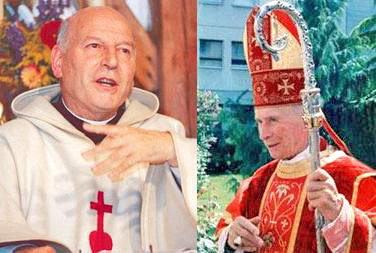
Abbé Georges de Nantes Monsignor Marcel Lefebvre
So, this only demonstrates further what a Conservative Right Winger
Pierre Plantard was during the 1960s and 1970s, long after his
wartime Alpha Galates activities.
The insertion of the name of
Jean Cocteau into the fictional Grand
Masters List of the fictional Priory of Sion was Philippe de Chèrisey's suggestion, on account of his interest in surrealism and
nothing else.
But there was no "Surrealist significance" to the
fictitious Priory of Sion from Plantard's position – the last mural
to be executed by Cocteau was left unfinished, and it featured
Godfrey de Bouillon – the fictitious founder of the fictitious
Priory of Sion.
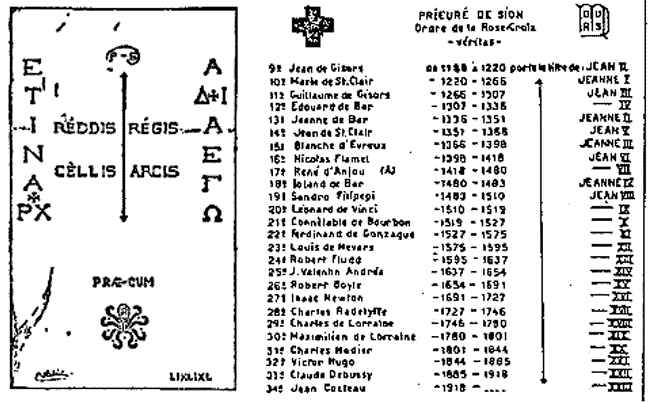
Most of the names found in the fictitious
List of Priory of Sion
Grand Masters (above image) originate from a document compiled by
Raymond Bernard
the former Grand Master of AMORC in France – and Plantard claimed to
have communicated with the spirit of Godfrey de Bouillon in seances.
Footnote
Piers Compton once made the hilarious claim that Pope John XXIII was
a "Rosicrucian" (in his 1981 book
The Broken Cross: Hidden Hand In
The Vatican).
It just so happens that Pope John XXIII was
responsible for starting Vatican Council Two during the early 1960s
which introduced a revised version of Catholicism that many
Traditionalist Catholics loathed – the dropping of Latin during the
ceremony of the Mass was just one of the measures that became
introduced.
Calling Pope John XXIII a "Rosicrucian" was just Piers Compton's way
of bad-mouthing the Pope. Compton did not know anything at all about Rosicrucianism.
Compton was in fact a former Catholic priest and the
Literary Editor of the Catholic Weekly 'The Universe' for 14 years.
Equally the same thing can be said about Malachi Martin when he
claimed there was "Satanism" going on in the Vatican (in his 1991
book The Keys of This Blood) – this was just a case of another
Catholic disliking the Papacy for another reason: the political
stance some Popes were taking – all too much for those Catholics who
disagreed – and rhetorical statements like "Luciferan conspiracy"
soon became banded about.
Pope John XXIII was not a "Rosicrucian" and there is no "Satanism"
going on in the Vatican. This is just a lot of hot air coming from
the Roman Catholic critics of the Papacy.
Back to Contents
The Merovingian
Dynasty
from
SATANIC BLOODLINE OF THE ANTICHRIST & FALSE
PROPHET
PIERRE PLANTARD DE SAINT-CLAIR
There are compelling reasons for our
conviction that the Antichrist will come from the Plantard and Saint-Clair
bloodlines.
Supporting evidence for this view will be presented throughout
this series, as well as information leading to discovery of the identity of
the False Prophet, a Merovingian as well.
The Messianic Legacy by
Baigent, Lincoln and
Leigh, Pierre Plantard de Saint-Claire joined the Prieuré de Sion on July 10,
1943 and, from 1963 to 1981, shared the position of Grand Master with Gaylord
Freeman, also of an Illuminati bloodline. (232:319;235-6)
According to Holy Blood, Holy Grail, Plantard de Saint-Claire was Grand
Master of the Prieuré de Sion from 1981 to 1984.
"A veritable secret society of 121 dignitaries, the
Prieuré de Sion, founded by Godfroi de Bouillon in Jerusalem in 1099, has
numbered among its Grand Masters Leonardo da Vinci, Victor Hugo and Jean
Cocteau. This Order convened its Convent at Blois on 17
January 1981...
As a result of this recent Convent at Blois,
Pierre
Plantard de Saint-Claire was elected grand master of the Order... This
choice of grand master marks a decisive step in the evolution of the Order’s
conception and spirit in relation to the world; for the 121 dignitaries of
the Prieuré de Sion are all éminences grises of high finance and of
international political or philosophical societies; and Pierre Plantard is
the direct descendant, through Dagobert II, of the Merovingian kings.
His
descent has been proved legally by the parchments of Queen Blanche of
Castile, discovered by the Abbe Sauniére in the church at Rennes-le-Château
(Aude) in 1891. These documents were sold by the priest’s niece in 1965 to
Captain Roland Stanmore and Sir Thomas Frazer, and were deposited in a
safe-deposit box of Lloyds Bank Europe Limited of London." (31:214-15)
It
seems that, following World War II, the Prieuré de Sion, and particularly
Pierre Plantard, were intimately involved with the rise of
Charles De Gaulle
rise to the presidency of France.(232:318)
According to The Messianic Legacy,
"Under the German occupation
and the Vichy regime, secret societies, including freemasonry, had been
strictly banned and membership of any such organization was subject to severe
penalties."
Springmeier states:
"It is hard for people to grasp that the Illuminati
controlled Russia, Great Britain, Germany and France during World War II,
but they did. Churchill, Roosevelt and Stalin were all Masons. DeGaulle of
France was closely linked with several esoteric groups, and the Prieuré de
Sion and Grand Orient Masons helped him to power in the 50s... the people of
the world weren’t ready for a world government, and most not even a united
Europe. W.W. II was carried out to adjust people’s thinking toward wanting
European unity." (77:168)
Front organizations were formed to agitate for change,
and the Prieuré de Sion assisted in the military coup that overthrew the Vichy
government, clearing the way for DeGaulle.
"Modelled on the Committees of Public Safety during the French
Revolution...the Committees [of Public Safety] began to agitate for a strong
guiding hand in France which would be sympathetic to their cause. Only one
person was deemed capable of providing such a hand - Charles de Gaulle. Thus
the Committees of Algeria began to press insistently for De Gaulle to assume
power in France, if necessary by means of a military coup.
They received
support from a number of high-ranking military men, including Marshal Alphonse Juin, who is alleged to have been an important member of the Prieuré de Sion. They also received
support from a coalescing pro-Gaullist movement in France... whose leaders
included Michel Debre - who became De Gaulle’s Minister of Justice and, shortly
after, between 1959 and 1962, Prime Minister of France. Another important
pro-Gaullist figure was Geoges Bidault... Between 1945 and 1954, Bidault had
worked closely with Robert Schuman... in drawing up plans for the EEC..." (232:330)
After De Gaulle was installed as President, however, he granted Algeria
independence from France, which weakened France as an imperial power.
Therefore, DeGaulle appointed Pierre Plantard secretary of a national ’Movement’ for the defense of liberty to succeed the Committees. As "minister
of propaganda," Plantard proceeded to dismantle and thereby defuse the
Committees of Public Safety which might turn against DeGaulle.
The
announcement was published by Plantard’s first wife, Anne Lea Hisler:
"When we first met M. Plantard in 1979, he told us that Charles de Gaulle had
personally requested him to direct the French Committees of Public Safety and,
when their task of installing the General in power had been completed, to
preside over their dissolution. In a mimeographed pamphlet deposited with the
Bibliothèque Nationale in 1964, Anne Lea Hisler - M. Plantard’s first
wife - states:
"Under the authority of Marshal Alphonse Juin, the seat of the
Secretariat-General of the Committees of Public Safety in metropolitan France
was at Aulnay-sous-Bois [Paris suburb]. This Committee was directed by Michel
Debr é, Pierre Plantard known
as Way, and André Malraux...a
member of the Prieure de Sion."
(232:333,256)
Anne Lea
Hisler, Plantard’s wife, worked with her husband on the magazine of the Prieuré
de Sion, CIRCUIT, an acronym for "Chivalry of Catholic Rules and Institutions of
the Independent and Traditionalist Union."
"...the
Prieuré de Sion was using its magazine for something other than its own
internal business.
"The 1959 series of
Circuit [contained] articles by Anne Lea Hisler and others, including
Pierre Plantard, sometimes writing under his own name, sometimes under the
pseudonym of ’Chyren’."
(232:339-40)
The name
"Hisler" happens to be an adaptation of "Hitler." The Decatur Daily reported in
2002,
"Fifty-seven years after his death, Hitler’s name still has shock
value, which may explain why so many people named Hitler - both in the United
States and abroad - had their names legally changed during World War II. (I know
a man named Hisler whose family name was spelled with a ’t’ instead of an ’s’ 60
years ago.) (1055)
The prophecies of Nostradamus included
"...a number of detailed prophecies concerning Hitler (whom he calls Hisler),
naming him as the ’second antiChrist’."
Was Anne Lea Hisler really
Anne Lea Hitler? Is
it possible that the wife of Pierre Plantard de Saint-Claire was related to the
infamous Adolf Hitler?
The Templar
Revelation confirms other reports of that Pierre Plantard de Saint-Claire at
least had Nazi sympathies:
"Born in 1920, he
first came to public notice in the Occupied France of 1942 as the editor of a
journal called Vaincre pour une Jeune cehvalerie (Conquest for a
Young Knighthood) - which was markedly
uncritical of the Nazi oppressors, and which was actually published with their
approval.
This was officially the organ of the Order Alpha Galates, a
quasi-Masonic and chivalric society, based in Paris, of which Plantard became
the Grand Master at the age of just twenty-two...Vaincre
is now [1998] the title of the Priory’s
internal bulletin, which Pierre de Saint-Clair edits with his son
Thomas." (242:43)
Back to Contents
THOMAS PLANTARD DE SAINT-CLAIR
The Grand Master of the Prieuré de Sion since 1989 has
been Thomas Plantard de Saint-Clair. According to Holy Blood, Holy Grail,
Thomas is the son of the former Grand Master, the late Pierre Plantard de
Saint-Clair.
The following announcement of Thomas’ election as Grand
Master was published in the internal bulletin of the Prieuré de Sion in 1989,
and only recently posted on the Internet.
|
Vaincre No. 3, September 1989, page
1
Managing
Editor: Thomas Plantard de Saint-Clair
110 Rue Henri
Dunant, 92700 COLOMBES
THOMAS
PLANTARD de Saint-Clair
becomes
Grandmaster of the PRIORY OF SION
By virtue of Article XIV OF THE CONSTITUTIONS
OF THE PRIORY OF SION: "their titles shall fall as of right to one of
their children to be designated by them without consideration of sex."
By virtue of article XVI "the various duties
and titles of Grandmaster of the Priory of Sion shall be transmissible
to their successor according to the same prerogatives."
By act dated 6 JULY 1989, Pierre PLANTARD de
SAINT-CLAIR, the present Grandmaster, informed the 121 Masters that,
in view of the favourable response of 107 votes in favour, 5
abstentions and 9 votes against accepting the proposed succession of
title and prerogative, ratification had been made on 6 AUGUST 1989 in
PARIS, at 10 o’clock solar time, and that THOMAS PLANTARD de
Saint-Clair had been proclaimed Grandmaster. Information has been sent
to all members of the ORDER. -
836:1 |
Merovingian sources collectively point to the
Plantards and Saint-Clairs as the bloodlines that will produce the Grail King,
the divine ruler, at once god and king, who will bring
mankind into a utopian age of peace and prosperity.
One piece of evidence for this choice is found in a
recent best-seller, The Da Vinci Code:
"Only two direct lines of Merovingians remain. Their family names are Plantard and Saint-Clair. Both
families live in hiding, probably protected by the Priory." -
935:260
According to Marjorie Reeves’ Joachim of Fiore and the Prophetic Future, a second
Charlemagne will arise whose surname begins with ’P’.
"It was a Burgundian World Emperor that
[Johann] Lichtenberger expected to arise as a Second Charlemagne. His hint
as to who this will be is quite plain: ’And it is said in the book of the
kings of the Franks that from the stock of King Charles of France
[Charlemagne] will arise in the last days an Emperor, ’nomine P.’, who will
be the monarch of all Europe and reform Church and clergy. After him there
shall be no ruler.’" -
823:110-111
E. W. Bullinger wrote in The Witness of the
Stars, after which recent pseudo-Christian books have been patterned:
"The
day has here come to fulfill the prophecies concerning Him who is ’the
Branch,’ ’the Branch of Jehovah,’ ’the man whose name is the
Branch.’"-
939
The Prieuré de Sion was formed and has been
directed by individuals related to the Saint-Clair bloodline. In Great
Britain, the surname of this so-called sacred lineage is Sinclair.
According to at least two Masonic sources, the Saint-Clairs are
Grand Masters of
Freemasonry by right of birth and they
have historically controlled the Prieuré de Sion.
"Through marriage the family of Marie Levis
St. Clair was connected to the de Gisors, the family from which the first
and third grand masters of the Prieuré de Sion came. Without question,
Prieuré de Sion was created and run by individuals related to the St.
Clairs. The third grand master was in charge in the year that the Templars
were ordered arrested and the treasure fleet set sail for Scotland to escape
the agents of the French king. Did one St. Clair (from France) correspond
with another Sinclair (from Scotland) for this express purpose? Most
likely the answer is yes." (Lost Treasure of the Knights Templar)
-
281:178
"Their domain [the Sinclair
family - Scottish branch of the Norman Saint-Clair Gisors
family] at Rosslyn was only a few miles from the former Scottish
headquarters of the Knights Templar, and the chapel at Rosslyn - built
between 1446 and 1486 - has long been associated with
both Freemasonry and the Rose-Croix. In a charter believed to date from
1601, moreover, the Sinclairs are recognized as ’hereditary’ grand masters
of Scottish Masonry.’ This is the earliest specifically Masonic document on
record. According to Masonic sources, however, the hereditary grand
mastership was conferred on the Sinclairs by James II, who ruled between
1437 and 1460 - the age of René d’Anjou." (Holy
Blood, Holy Grail) -
31:183
In
addition to conditioning the masses to believe their New Age
propaganda, another objective of best-selling New Age books such as Holy
Blood, Holy Grail is to covertly communicate secret information from the Prieuré de Sion to a specific audience
- the global network of secret societies
and New Age cults, all of which eagerly await the end of the Age of Pisces and
the beginning of the Age of Aquarius.
At that point in time, the much despised
Church Age will come to a close and Lucifer, in the person of the Antichrist,
will reign over a Golden Age, having destroyed the Harlot Church which no
longer serves his purposes.
In Holy Blood, Holy Grail, there is a
childhood photo of Thomas Plantard de Saint-Clair seated on the lap of
Pierre Plantard de Saint-Clair.
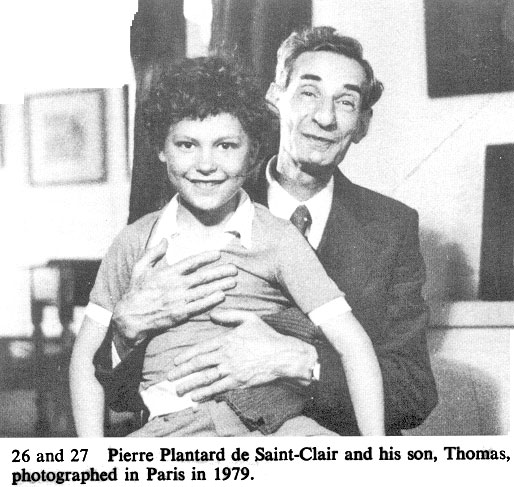
This peculiar photograph of
Thomas Plantard, seated on the lap of Pierre, is conveying an esoteric message to the
occultist.
Please take note of the pose, Thomas sitting on the lap of
Pierre. Below are some photographs of famous Black Virgins, also
called Black Madonnas.
Note the striking similarity of the poses of
Pierre Plantard de Saint-Clair with Thomas and the Black Virgins with their
sons who were child gods.
Notice also the masculine appearance of the ’Madonnas’ and the placement of their sons between their legs:
|
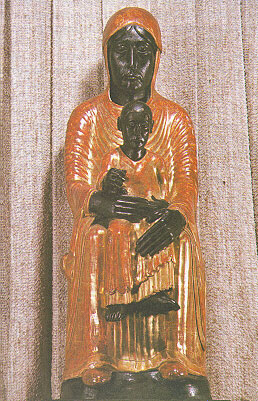
Notre-Dame de Marsat
Marsat Puy-de-Dôme,
France |
"Our
ancient, battered, much-loved, little-understood Black Virgins are a
still-living archetypal image that lies at the heart of our civilization
and has a message for us.... The light of nature tells us that life is a
pilgrimage, a journey to the stars along the Milky Way, her hero-path, a
voyage across the great water in which she is the ship, rudder, and
guiding star.
"There is clearly no return to
the twelfth century, the third century or the third millennium BC.
Inanna, Sophia, the Holy Grail and the Church of Amor [Catharism]
are no longer available as living realities for us today. There are
signs that the goddess now requires to be worshipped in spirit and in
truth through the law written in our hearts, rather than in temples
built with hands. One old truth is that man and woman, though different,
are equal parts of a consciously androgynous whole that is each
person’s potential reality. Many people, shown photographs of the
Black Virgin for the first time, comment on how
masculine some of them look." (Ean Begg, The Cult of the
Black Virgin) -
272:13,134 |
|
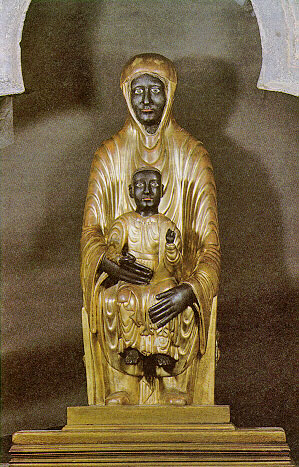
Notre Dame de
Clermont
Clermont-Ferrand,
Puy-de-Dome, France |
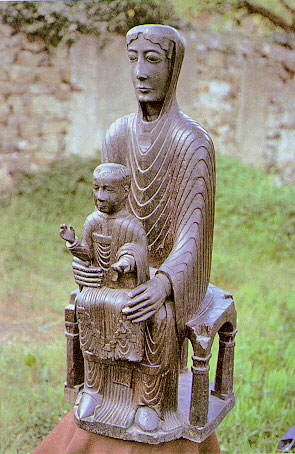
Notre Dame
de Laval (Loire) France
Brought
back from Crusades by St. Louis
|
|
Notre Dame de Meymac, also known as the Black
Madonna of Meymac is believed to have been carved sometime during the
11th century.
The Black Virgin has very large hands and a red cloak; and
has been called one of the strangest and most interesting Black Madonnas
to date.
The Child is dressed in red with bare feet, and sits between
the Madonna’s knees, holding a closed book in his left hand.
This Black Virgin was once part of the 11th
century treasure of Benedictine priory of Saint Andrew, originally a
hermitage in and during the Merovingian Dynasty...
This is one of the Madonnas of the Fisher
Kings, the Merovingian line of Mystic Kings, keepers of the Grail
Bloodline.
Black Madonnas are believed to be pre-Christian
archetypes whose child-nurturing focus is the embodiment of the
pre-historic Great Mother.
A very powerful
and important Madonna, She regally sits an impressive 8.5 inches tall.
This gothic style icon is found in the French village of Correze.-
925
|
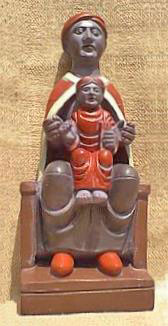
Notre Dame de Meymac
Meymac,
Correze, France |
|
"Whoever the enigmatic Black Virgin may be, she holds a powerful
attraction for her millions of devotees around the world. Her sacred sites stand on highly
charged earth energy centers, enhanced by megalithic ley-lines and sacred
architecture.
"From ancient
times to present, people have undertaken pilgrimages to her shrines as a
way to explore her mysteries and to enable her to do her miraculous work
of healing, transformation and inspiration. France has more than 300
Black Virgin sites, with over 150 Black Virgins still in
existence." |
|
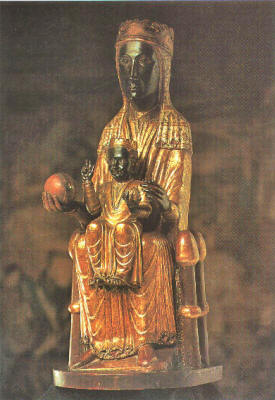
click image to enlarge |
Notre-Dame de Montserrat
La Moreneta * Montserrat
Katalonien, Spain
"Beyond general style, the genre of the statue is
certainly that of an ’enthroned virgin’, typical of the earliest icons
of Mary. On behalf of Madonna and Child representations, Stephen Benko
notes: It is well known that the iconography of Isis and [her son] Horus
was basically adopted by Christians when they started to portray Mary
and Jesus as Mother and Child.’ Benko adds that Isis was sometimes ’pictured as black’... the Montserrat figures [and] over 1,000 of the
world’s better known Madonnas are black...
"...Montserrat is located in Spain, not in France
where St.
Bernard of Clairvaux (the nephew of one of the original nine Knight
Templars) and others produced well-known commentaries on the Canticles.
Perhaps the image was created black to represent some esoteric religious
symbolism. Ean Begg notes that the Shrine of Montserrat is among the
best candidates for former sanctuaries for the Holy Grail. Further,
in the twelfth and thirteenth centuries esoteric Christian sects
proliferated, though not primarily in Spain." -
925 |
Will Thomas Plantard de Saint-Clair be
revealed as the reincarnation of Horus, i.e. Nimrod, who will at last unite
the world under Lucifer?
Recall that the myth of Horus is a distortion
of the Genesis account of God’s judgment on the Tower of Babel. (Gen. 10 and
11)
Not happy with this arrangement, New Agers anticipate the return of Horus
as the reincarnation of Nimrod who will finally unite mankind in a glorious
revolution which dethrones God.
"Like the goddess Isis, who found and
restored all of the lost pieces of her husband, Osiris, many are restoring
the unity of all life, bringing together the separate parts of
humanity - different races, religions and cultures." -
42:62
Back to
Contents
|









